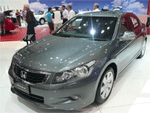Difference Between Honda Accord and Opel Insignia
 Honda Accord vs. Opel Insignia
Honda Accord vs. Opel Insignia
What do German automakers have that differentiates their vehicles from all the rest? It’s the touch of luxury, excellent build and ride quality, and many times, a hefty price tag. All these characteristics are rather opposite to Japanese made vehicles. Practicality, reliability and economical are the words that come to mind, but, is that all there is to these vehicles, considering that the benchmark Honda Accord sedan has already become a western brand for decades? Let’s find out by comparing two mainstream brands: One European Opel Insignia and one Japanese Honda Accord, coming right up!
First we break down each vehicle’s data starting with the base Honda Accord LX. It has a 2.4L inline-4 that is mated to a 5-speed manual transmission gearbox, and produces 177 horsepower at 6,500rpm. This thrifty engine has a fuel economy of 25 miles per gallon for city and highway driving. The manufacturer’s suggested retail price for this model starts at $21,765.
It offers 4-wheel ABS on ventilated disc brakes. In terms of curb weight, the Accord LX comes out in a slightly trimmer 3230 lbs., supported by 16-inch alloy wheels wrapped in 215/60 All-Season tires.
The base model of the Opel Insignia Essentia, on the other hand, starts with a price tag of $32,126, and for that you get a front-wheel driven car, with a 1.8L inline-4 ECOTEC engine attached to a 6-speed manual transmission, which can tap out a maximum of 115hp at 5600rpm. Opel’s new engine can deliver a very fuel efficient 28mpg, despite the car being a hefty 3314 lbs. This weight is resting on 16′ steel wheels, with 215/60 sized radial tires.
Now, the standard equipment for the entry-level Essentia model features the following: 4-wheel ABS with ventilated disc brakes; front, side and window airbags; Isofix anchorage on all three rear seats; air conditioning; stereo system CD; power mirrors; a 60/40 folding rear seat; on-board computer; power adjustable driver’s seat; and front and rear local lamps, as well as ESP and traction control.
One must remember though, that all this data is for the entry-level models only, for both car manufacturers, and things get a bit more upscale, more competitive and pricier as you go up the different trim levels. The Accord offers three different trim levels, namely, the base LX, the upgraded EX, and the top of the line EX-L, which offers premium features, such as leather upholstery and an optional navigation system.
As for the Opel Insignia, there are two body versions available for the market-sedan, hatchback or station wagon, and four trim variants, namely, the Essentia, Edition, Sport and Cosmo. It also comes with a broad range of seven engines: Four gasoline engines ranging from a 1.8L 4-cylinder 115hp unit to a 2.8L V6 with 260hp; and three new direct-injection diesels, which feature a displacement of 2.0 liters, and have outputs spanning from 110 to 160hp. Although there is the high performance Insignia OPC, with its turbocharged V6 engine, we’ll save that one for another comparison test.
Some of the features on the Opel Insignia are ‘as European as they come’, and this only sets it apart from the competition. The westernized Honda Accord LX would seem to be no match for the Opel at this point, but it still holds extra aces for pricing, and a solid reputation in the market. So, if you are looking for more luxurious touches in a car close to the Opel’s price tag, get the Accord EX-L instead, and some change for your wallet.
- Difference Between Honda Accord and Opel Insignia - February 5, 2010
- Difference Between Nissan Teana and Honda Accord - February 4, 2010
- Difference Between Subaru Legacy and Honda Accord - February 4, 2010

opel is better